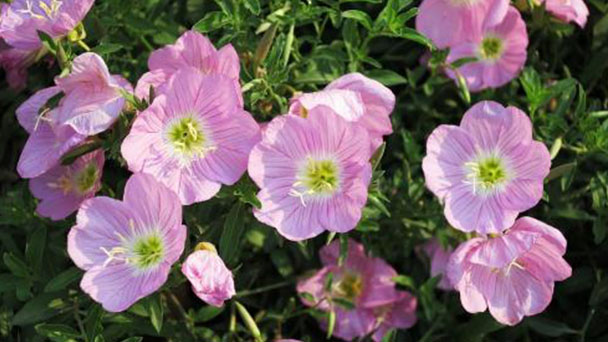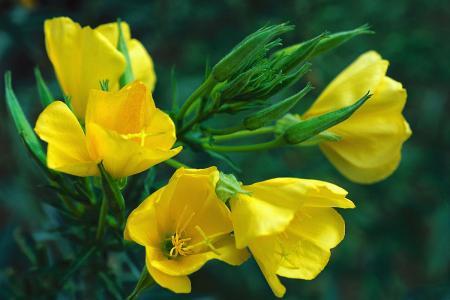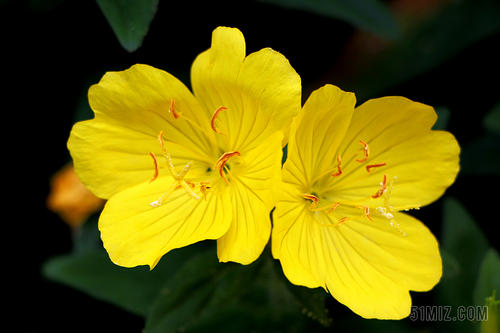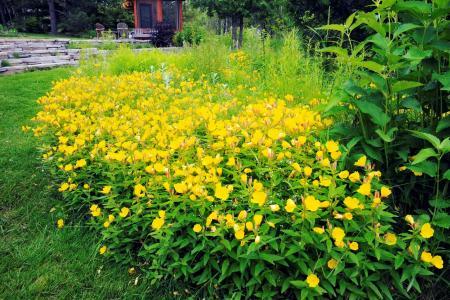Evening primrose (Oenothera biennis) profile
Written by Maggie
Apr 25 2021

The beautiful name of the evening primrose comes from the fact that it blooms in the evening and dies in the morning. Evening primrose has been used by Indians in America for more than a thousand years to overcome many ailments (pain relief, asthma, etc.). In the 17th century, evening primrose was known as the "imperial elixir" and was widely used by European aristocrats. Evening primrose has a long history of being used in European and American countries to relieve the discomfort of the female menstrual cycle. It is one of the most common herbs that women rely on. Strictly speaking, evening primrose is native to the Americas and prefers to grow in sunny, dry, sandy or stony environments.It is an annual or biennial plant with long pointed leaves that flower only the next year and bear fruit immediately after flowering.Seeds containing oil, one of the oil plants.
Evening primrose pictire

Evening primrose info
| Botanical Name | Oenothera biennis |
| Common Names | Evening primrose, common evening primrose, tree primrose, fever plant, cure-all, night willow-herb |
| Plant Type | Herbaceous perennial |
| Sun | Full sun, partial shade |
| Hardiness Zones | 4–9 (USDA) |
| Flower color | Yellow |
| Native Area | North America |
| Mature size | 3–5 ft. tall, 2–3 ft. wide |
Evening primrose features
Evening primrose stem is erect, 20-60 cm tall, divergent from the base, burr, densely hairy. Leaves are alternate, stipitate, 1 -- 8 cm long, 0.5 -- 4 cm wide, elliptic to lanceolate or obovate, base obtuse, apex acute, serrate margin to undulate, pale green, soft. Spicate is branchelike apex, yellow flowers, pedicle, flowering in April - May. Evening primrose has 2 sepals, 1.5 -- 3 cm long and 0.2 -- 0.4 cm wide, margin recumbent when flowering. Flower tube is 1 -- 3 cm long, apex diameter 0.3 -- 0.6 cm, petals 4, 1.5 -- 3.5 cm long, white, obcordate, slightly concave head. Evening primrose has 8 stamens, filaments 1-1.5 cm long, white, green near the base. Ovary is inferior, 4-ribbed, green, style 2-4 cm long, white, stigma greenish. Capsule is obovoid. Evening primrose has many seeds, about 0.1 cm long.
The root of Evening primrose is mainly used for medicinal use. It has a sweet taste and warm nature. It can relieve wind and dehumidify, strengthen muscles and bones, and specially cure rheumatic muscles and bones. Seed oil can promote blood circulation, calm the liver, reduce swelling and sores, treat chest pain, stroke hemiplegia, internal movement of deficiency wind, hyperactivity in children, rheumatism, numbing pain, abdominal pain, diarrhea, dysmenorrhea, sore selection, eczema and so on.
How to grow and care for evening primrose
Light
Contrary to what you may additionally agree with about a plant that solely blooms at night time (making it ideal for moon gardens), nighttime primrose definitely loves sunlight. It need to be grown in a spot that receives full daylight (or partial shade), and someplace the place the plant can soak in at least six to eight hours of heat daylight daily.
Soil
Another essential requirement for developing nighttime primrose effectively is soil that boasts accurate drainage. That being said, Evening primrose needs to nonetheless keep moisture, simply now not emerge as water-logged. Consider including a thick layer of mulch atop the soil to assist maintain the roots cool at some point of the summer.
Water
Evening primrose does first-class with enough ordinary watering and will want a bit extra water if grown in an specifically warm local weather all through the summer. However, if you be aware any discoloration or browning on the plant's many leaves, it truly is a positive signal that your night primrose is getting too an awful lot water and is in all likelihood struggling from root rot or a fungal disease.
Temperature and Humidity
While it blooms and grows nice for the duration of the summer, Evening primrose in reality prefers to be cool as a substitute than warm. The plant desires to get installed (i.e. develop its roots and foliage) at some stage in the cooler early months of spring in order to flower properly come summer. Too a whole lot warmness early on in its existence can motive the plant to grow to be leggy or resemble a weed in appearance.
Fertilizer
Fertilizer is no longer a indispensable addition to your nighttime primrose care regimen—it will develop simply high-quality besides the extra nutrients. However, if you are working with especially terrible soil, you can amend your combination with some natural material.

Is Evening Primrose Toxic?
Although it has various ingestible makes use of for humans, night primrose is regarded mildly poisonous to pets by means of some veterinarians. Though not often toxic ample to motive predominant issues, you must nonetheless be conscious of your pets round the plant. If you word your canine or cat exhibiting any of the under symptoms, contact your vet immediately.
Symptoms of Poisoning
Vomiting
Upset stomach
Diarrhea
Skin irritation
Eye irritation
Gastrointestinal inflamation
How to Grow Evening Primrose From Seed
Evening primrose is commonly grown from seed and, though you can purchase the seeds online, you can simply as effortlessly accumulate seeds from wild plant life developing alongside the roadside or in public gardens. Once you get nighttime primrose seeds, plant them both in autumn or early spring in a region that boasts full solar the place the soil has been until now cultivated. Sow the seeds on pinnacle of the soil and water well. After germination, skinny the seedlings so that they are about one foot apart.
In its first yr of life, nighttime primrose will now not flower however will genuinely produce a leafy rosette at floor level. Come yr two, a tall, stiff flower stem shoots up out of this base. About halfway up this flower stem, secondary branching takes place and the leaves end up gradually smaller the farther you go up the flower stem. The four-petaled blooms that commence rising at the begin of summer time are about one inch wide. They'll in the end die off and produce seeds, which are then unfold during the panorama with the aid of a range of climate stipulations or eaten by means of wild birds.
Evening primrose common pests and diseases
Varieties beetles consume the leaves of night primrose, however they might not do adequate harm to kill the plant. Otherwise, you can anticipate to see quite a number different standard backyard pests periodically, such as mealybugs, spider mites, and aphids. If you observe signs and symptoms of contamination on your plants, deal with them with insecticidal cleaning soap or an oil such as neem oil.

Latest Updated
- Benefits of Bugleweed - 7 Science-backed Health Benefits
- Bugleweed Dangers & Side Effects - Is It Poisonous?
- How to Plant Evergreen Trees - What You Should Know
- When to Plant Evergreens - Grow Guide for Evergreen Trees
- 12 Wonderful Evergreen Shrubs for Your Garden
- 12 Popular Evergreen Plants with Pictures for Beginners
- When And How To Prune A Lilac Bush Like a Pro
- How to Grow & Care for Lilac Vine (Hardenbergia Violacea)
- Japanese Lilac Tree (Syringa Reticulata) Care & Propagation Guide
- Shumard Oak Pros and Cons - What to Know
Popular Articles
- Winter maintenance of Antirrhinum Majus
- How to Grow Terminalia Mantaly Tree
- How to Grow and Care for Crossostephium Chinense
- How to grow Antirrhinum Majus in spring
- Peristeria Elata (Dove Orchid) Profile: Info & Care Guide
- Underwatered Snake Plant (Sansevieria Trifasciata) - Signs And How To Fix
- How to Care for Brazilian Jasmine Plant (Mandevilla Sanderi)
- How to Grow & Care for Graptopetalum Purple Delight in Summer
- Rosa Chinensis (China Rose): Plant Growing & Care Tips
- How to Care for Baby Sun Rose (Aptenia Cordifolia)